Critical Appraisal of a Peer-Reviewed Qualitative Study Worksheet
VerifiedAdded on 2022/09/14
|10
|2092
|13
Practical Assignment
AI Summary
This assignment focuses on the critical appraisal of a peer-reviewed qualitative journal article. The student was tasked with selecting an article and using a provided worksheet to evaluate its methodological rigor, trustworthiness, and ethical considerations. The analysis included assessing the appropriateness of the qualitative approach, the congruity between philosophical perspectives, research questions, methods, and analysis. The student examined the research design, sampling methods, data collection and analysis techniques, and the reporting of results, including limitations and conclusions. The assignment required the student to substantiate their comments with examples from the article and support arguments with references. The student also considered the relevance of the findings to public health practice and how the findings can be applied to practice. The student found and analyzed the article, "Exploring factors influencing childhood obesity prevention among migrant communities in Victoria, Australia: A qualitative study" by Renzaho, A. M., Green, J., Smith, B. J., & Polonsky, M. (2018).
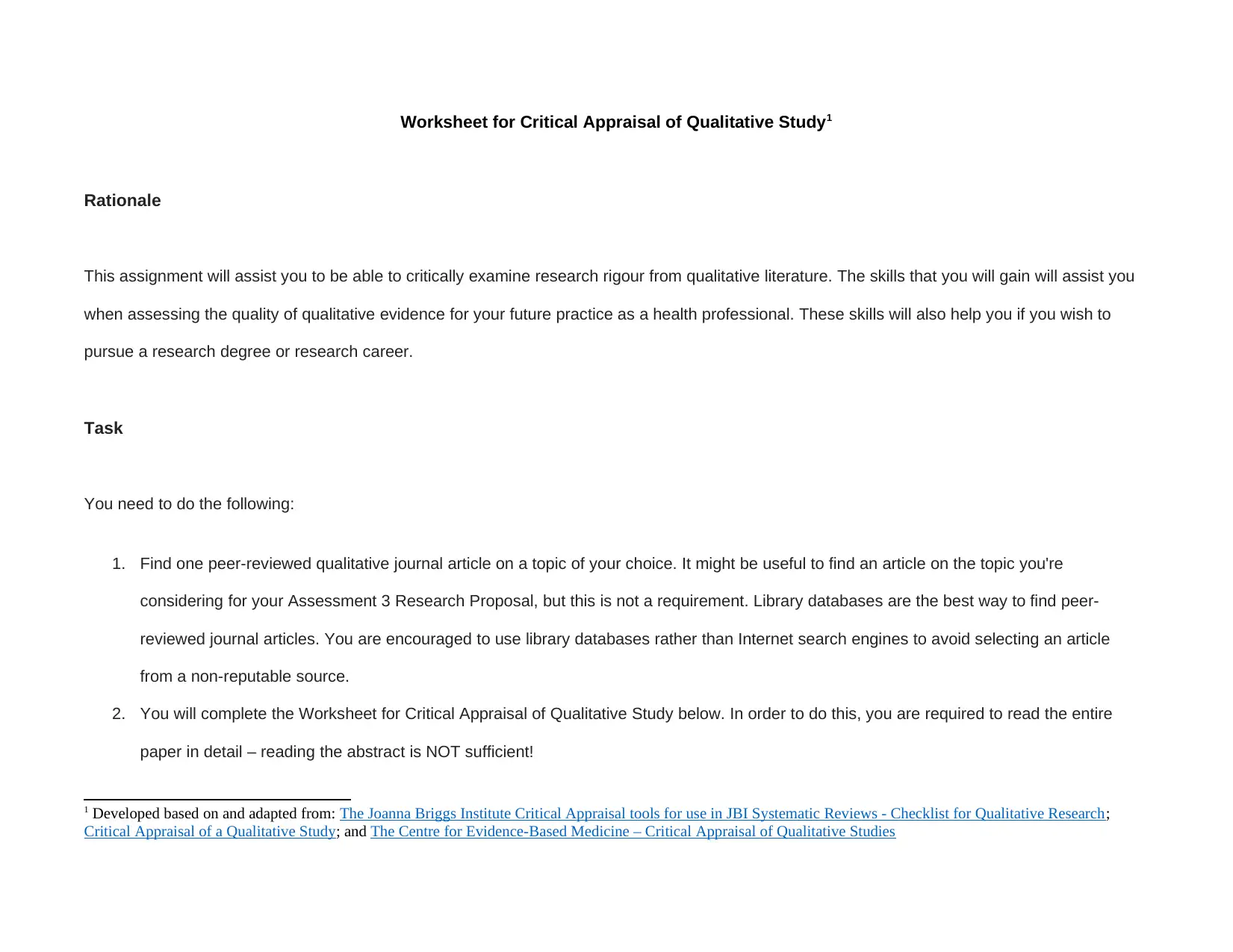
Worksheet for Critical Appraisal of Qualitative Study1
Rationale
This assignment will assist you to be able to critically examine research rigour from qualitative literature. The skills that you will gain will assist you
when assessing the quality of qualitative evidence for your future practice as a health professional. These skills will also help you if you wish to
pursue a research degree or research career.
Task
You need to do the following:
1. Find one peer-reviewed qualitative journal article on a topic of your choice. It might be useful to find an article on the topic you're
considering for your Assessment 3 Research Proposal, but this is not a requirement. Library databases are the best way to find peer-
reviewed journal articles. You are encouraged to use library databases rather than Internet search engines to avoid selecting an article
from a non-reputable source.
2. You will complete the Worksheet for Critical Appraisal of Qualitative Study below. In order to do this, you are required to read the entire
paper in detail – reading the abstract is NOT sufficient!
1 Developed based on and adapted from: The Joanna Briggs Institute Critical Appraisal tools for use in JBI Systematic Reviews - Checklist for Qualitative Research;
Critical Appraisal of a Qualitative Study; and The Centre for Evidence-Based Medicine – Critical Appraisal of Qualitative Studies
Rationale
This assignment will assist you to be able to critically examine research rigour from qualitative literature. The skills that you will gain will assist you
when assessing the quality of qualitative evidence for your future practice as a health professional. These skills will also help you if you wish to
pursue a research degree or research career.
Task
You need to do the following:
1. Find one peer-reviewed qualitative journal article on a topic of your choice. It might be useful to find an article on the topic you're
considering for your Assessment 3 Research Proposal, but this is not a requirement. Library databases are the best way to find peer-
reviewed journal articles. You are encouraged to use library databases rather than Internet search engines to avoid selecting an article
from a non-reputable source.
2. You will complete the Worksheet for Critical Appraisal of Qualitative Study below. In order to do this, you are required to read the entire
paper in detail – reading the abstract is NOT sufficient!
1 Developed based on and adapted from: The Joanna Briggs Institute Critical Appraisal tools for use in JBI Systematic Reviews - Checklist for Qualitative Research;
Critical Appraisal of a Qualitative Study; and The Centre for Evidence-Based Medicine – Critical Appraisal of Qualitative Studies
Paraphrase This Document
Need a fresh take? Get an instant paraphrase of this document with our AI Paraphraser
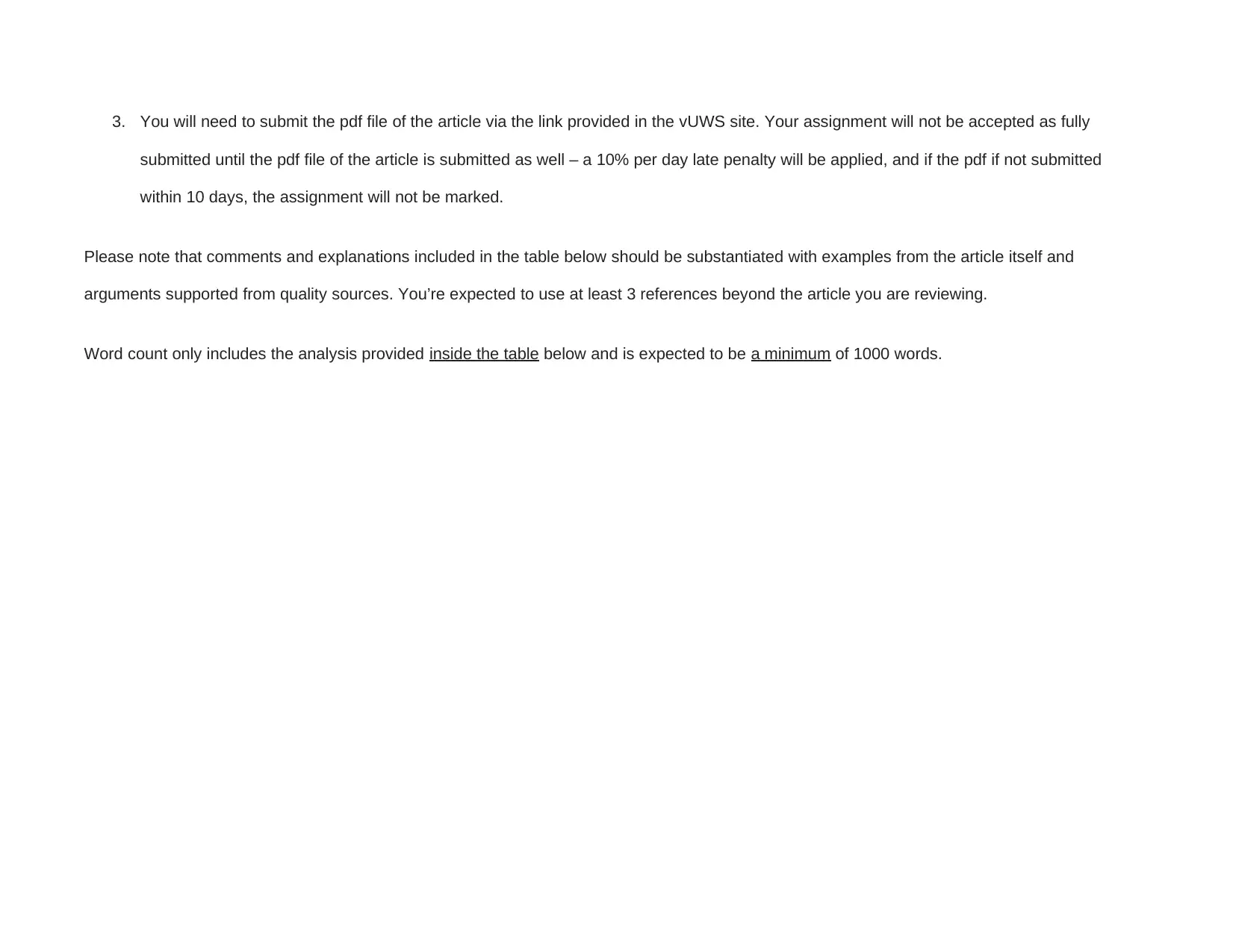
3. You will need to submit the pdf file of the article via the link provided in the vUWS site. Your assignment will not be accepted as fully
submitted until the pdf file of the article is submitted as well – a 10% per day late penalty will be applied, and if the pdf if not submitted
within 10 days, the assignment will not be marked.
Please note that comments and explanations included in the table below should be substantiated with examples from the article itself and
arguments supported from quality sources. You’re expected to use at least 3 references beyond the article you are reviewing.
Word count only includes the analysis provided inside the table below and is expected to be a minimum of 1000 words.
submitted until the pdf file of the article is submitted as well – a 10% per day late penalty will be applied, and if the pdf if not submitted
within 10 days, the assignment will not be marked.
Please note that comments and explanations included in the table below should be substantiated with examples from the article itself and
arguments supported from quality sources. You’re expected to use at least 3 references beyond the article you are reviewing.
Word count only includes the analysis provided inside the table below and is expected to be a minimum of 1000 words.
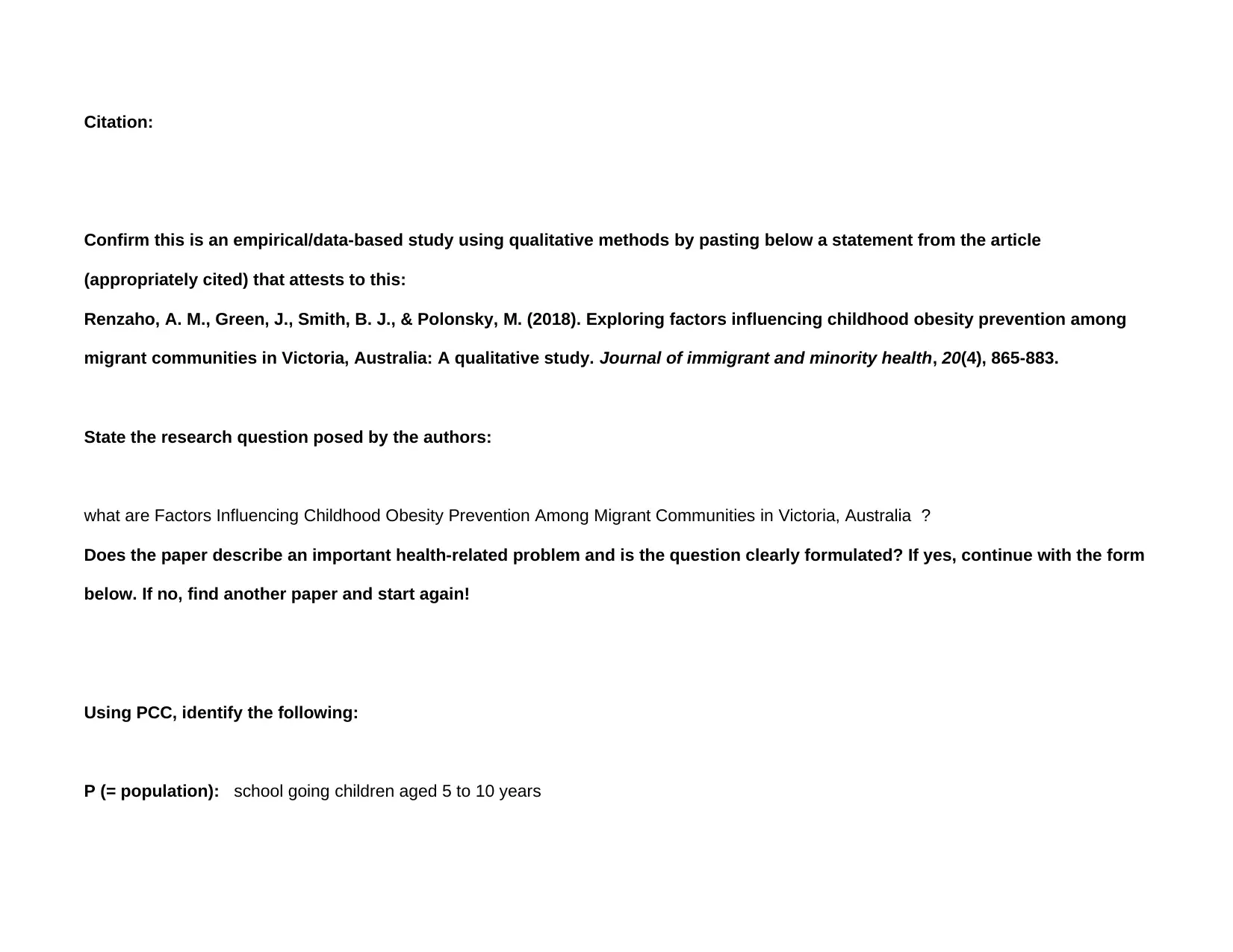
Citation:
Confirm this is an empirical/data-based study using qualitative methods by pasting below a statement from the article
(appropriately cited) that attests to this:
Renzaho, A. M., Green, J., Smith, B. J., & Polonsky, M. (2018). Exploring factors influencing childhood obesity prevention among
migrant communities in Victoria, Australia: A qualitative study. Journal of immigrant and minority health, 20(4), 865-883.
State the research question posed by the authors:
what are Factors Influencing Childhood Obesity Prevention Among Migrant Communities in Victoria, Australia ?
Does the paper describe an important health-related problem and is the question clearly formulated? If yes, continue with the form
below. If no, find another paper and start again!
Using PCC, identify the following:
P (= population): school going children aged 5 to 10 years
Confirm this is an empirical/data-based study using qualitative methods by pasting below a statement from the article
(appropriately cited) that attests to this:
Renzaho, A. M., Green, J., Smith, B. J., & Polonsky, M. (2018). Exploring factors influencing childhood obesity prevention among
migrant communities in Victoria, Australia: A qualitative study. Journal of immigrant and minority health, 20(4), 865-883.
State the research question posed by the authors:
what are Factors Influencing Childhood Obesity Prevention Among Migrant Communities in Victoria, Australia ?
Does the paper describe an important health-related problem and is the question clearly formulated? If yes, continue with the form
below. If no, find another paper and start again!
Using PCC, identify the following:
P (= population): school going children aged 5 to 10 years
⊘ This is a preview!⊘
Do you want full access?
Subscribe today to unlock all pages.

Trusted by 1+ million students worldwide
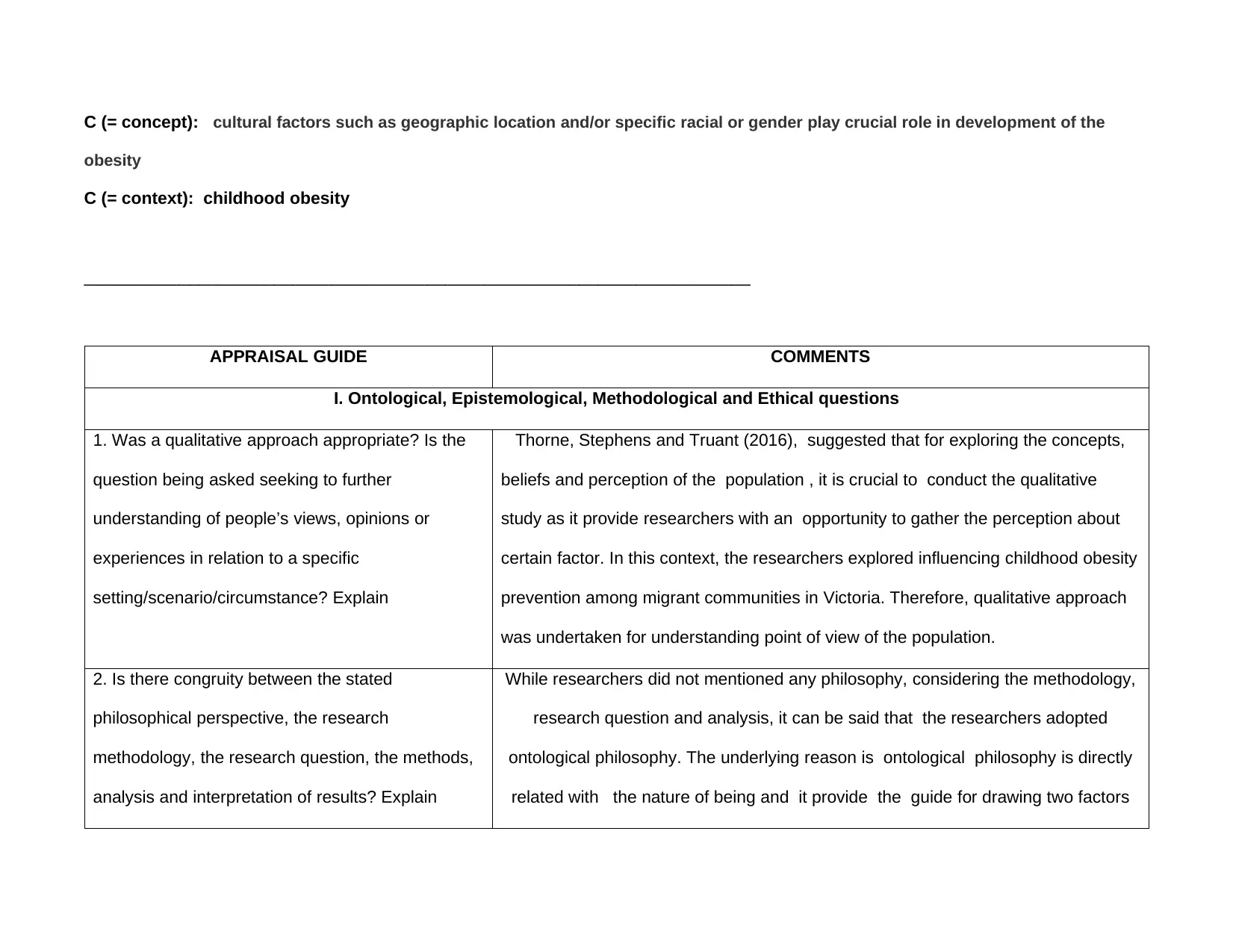
C (= concept): cultural factors such as geographic location and/or specific racial or gender play crucial role in development of the
obesity
C (= context): childhood obesity
______________________________________________________________________
APPRAISAL GUIDE COMMENTS
I. Ontological, Epistemological, Methodological and Ethical questions
1. Was a qualitative approach appropriate? Is the
question being asked seeking to further
understanding of people’s views, opinions or
experiences in relation to a specific
setting/scenario/circumstance? Explain
Thorne, Stephens and Truant (2016), suggested that for exploring the concepts,
beliefs and perception of the population , it is crucial to conduct the qualitative
study as it provide researchers with an opportunity to gather the perception about
certain factor. In this context, the researchers explored influencing childhood obesity
prevention among migrant communities in Victoria. Therefore, qualitative approach
was undertaken for understanding point of view of the population.
2. Is there congruity between the stated
philosophical perspective, the research
methodology, the research question, the methods,
analysis and interpretation of results? Explain
While researchers did not mentioned any philosophy, considering the methodology,
research question and analysis, it can be said that the researchers adopted
ontological philosophy. The underlying reason is ontological philosophy is directly
related with the nature of being and it provide the guide for drawing two factors
obesity
C (= context): childhood obesity
______________________________________________________________________
APPRAISAL GUIDE COMMENTS
I. Ontological, Epistemological, Methodological and Ethical questions
1. Was a qualitative approach appropriate? Is the
question being asked seeking to further
understanding of people’s views, opinions or
experiences in relation to a specific
setting/scenario/circumstance? Explain
Thorne, Stephens and Truant (2016), suggested that for exploring the concepts,
beliefs and perception of the population , it is crucial to conduct the qualitative
study as it provide researchers with an opportunity to gather the perception about
certain factor. In this context, the researchers explored influencing childhood obesity
prevention among migrant communities in Victoria. Therefore, qualitative approach
was undertaken for understanding point of view of the population.
2. Is there congruity between the stated
philosophical perspective, the research
methodology, the research question, the methods,
analysis and interpretation of results? Explain
While researchers did not mentioned any philosophy, considering the methodology,
research question and analysis, it can be said that the researchers adopted
ontological philosophy. The underlying reason is ontological philosophy is directly
related with the nature of being and it provide the guide for drawing two factors
Paraphrase This Document
Need a fresh take? Get an instant paraphrase of this document with our AI Paraphraser
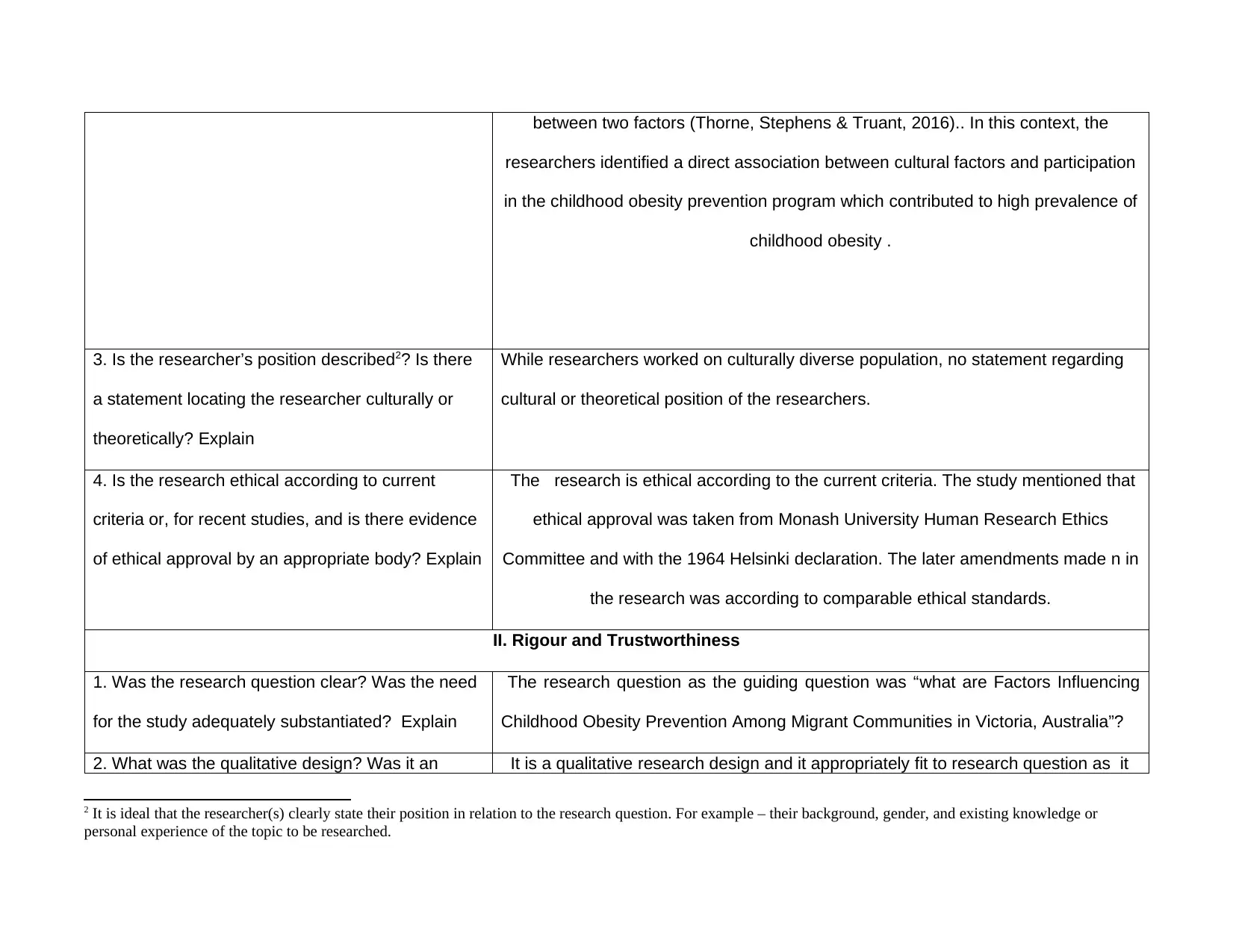
between two factors (Thorne, Stephens & Truant, 2016).. In this context, the
researchers identified a direct association between cultural factors and participation
in the childhood obesity prevention program which contributed to high prevalence of
childhood obesity .
3. Is the researcher’s position described2? Is there
a statement locating the researcher culturally or
theoretically? Explain
While researchers worked on culturally diverse population, no statement regarding
cultural or theoretical position of the researchers.
4. Is the research ethical according to current
criteria or, for recent studies, and is there evidence
of ethical approval by an appropriate body? Explain
The research is ethical according to the current criteria. The study mentioned that
ethical approval was taken from Monash University Human Research Ethics
Committee and with the 1964 Helsinki declaration. The later amendments made n in
the research was according to comparable ethical standards.
II. Rigour and Trustworthiness
1. Was the research question clear? Was the need
for the study adequately substantiated? Explain
The research question as the guiding question was “what are Factors Influencing
Childhood Obesity Prevention Among Migrant Communities in Victoria, Australia”?
2. What was the qualitative design? Was it an It is a qualitative research design and it appropriately fit to research question as it
2 It is ideal that the researcher(s) clearly state their position in relation to the research question. For example – their background, gender, and existing knowledge or
personal experience of the topic to be researched.
researchers identified a direct association between cultural factors and participation
in the childhood obesity prevention program which contributed to high prevalence of
childhood obesity .
3. Is the researcher’s position described2? Is there
a statement locating the researcher culturally or
theoretically? Explain
While researchers worked on culturally diverse population, no statement regarding
cultural or theoretical position of the researchers.
4. Is the research ethical according to current
criteria or, for recent studies, and is there evidence
of ethical approval by an appropriate body? Explain
The research is ethical according to the current criteria. The study mentioned that
ethical approval was taken from Monash University Human Research Ethics
Committee and with the 1964 Helsinki declaration. The later amendments made n in
the research was according to comparable ethical standards.
II. Rigour and Trustworthiness
1. Was the research question clear? Was the need
for the study adequately substantiated? Explain
The research question as the guiding question was “what are Factors Influencing
Childhood Obesity Prevention Among Migrant Communities in Victoria, Australia”?
2. What was the qualitative design? Was it an It is a qualitative research design and it appropriately fit to research question as it
2 It is ideal that the researcher(s) clearly state their position in relation to the research question. For example – their background, gender, and existing knowledge or
personal experience of the topic to be researched.
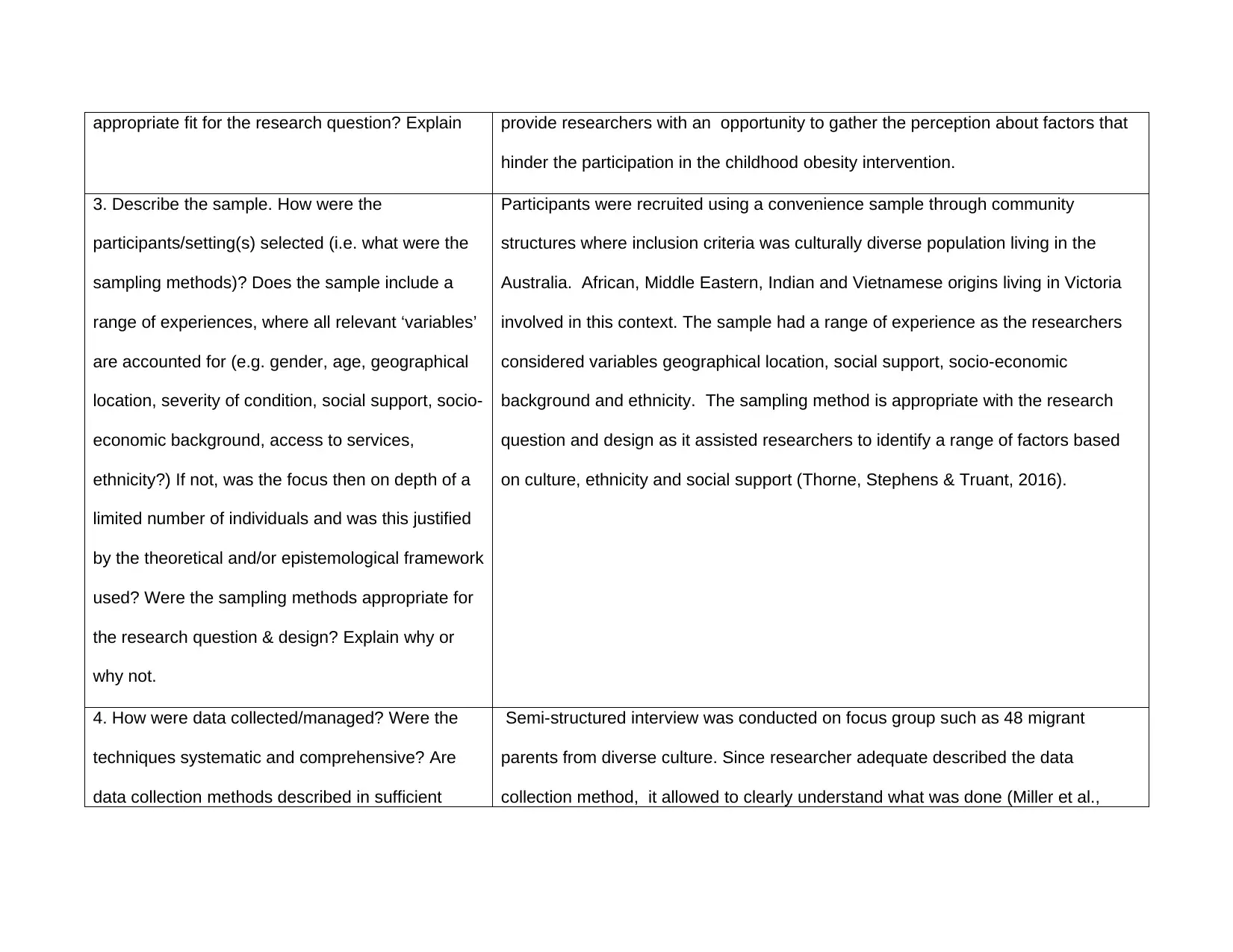
appropriate fit for the research question? Explain provide researchers with an opportunity to gather the perception about factors that
hinder the participation in the childhood obesity intervention.
3. Describe the sample. How were the
participants/setting(s) selected (i.e. what were the
sampling methods)? Does the sample include a
range of experiences, where all relevant ‘variables’
are accounted for (e.g. gender, age, geographical
location, severity of condition, social support, socio-
economic background, access to services,
ethnicity?) If not, was the focus then on depth of a
limited number of individuals and was this justified
by the theoretical and/or epistemological framework
used? Were the sampling methods appropriate for
the research question & design? Explain why or
why not.
Participants were recruited using a convenience sample through community
structures where inclusion criteria was culturally diverse population living in the
Australia. African, Middle Eastern, Indian and Vietnamese origins living in Victoria
involved in this context. The sample had a range of experience as the researchers
considered variables geographical location, social support, socio-economic
background and ethnicity. The sampling method is appropriate with the research
question and design as it assisted researchers to identify a range of factors based
on culture, ethnicity and social support (Thorne, Stephens & Truant, 2016).
4. How were data collected/managed? Were the
techniques systematic and comprehensive? Are
data collection methods described in sufficient
Semi-structured interview was conducted on focus group such as 48 migrant
parents from diverse culture. Since researcher adequate described the data
collection method, it allowed to clearly understand what was done (Miller et al.,
hinder the participation in the childhood obesity intervention.
3. Describe the sample. How were the
participants/setting(s) selected (i.e. what were the
sampling methods)? Does the sample include a
range of experiences, where all relevant ‘variables’
are accounted for (e.g. gender, age, geographical
location, severity of condition, social support, socio-
economic background, access to services,
ethnicity?) If not, was the focus then on depth of a
limited number of individuals and was this justified
by the theoretical and/or epistemological framework
used? Were the sampling methods appropriate for
the research question & design? Explain why or
why not.
Participants were recruited using a convenience sample through community
structures where inclusion criteria was culturally diverse population living in the
Australia. African, Middle Eastern, Indian and Vietnamese origins living in Victoria
involved in this context. The sample had a range of experience as the researchers
considered variables geographical location, social support, socio-economic
background and ethnicity. The sampling method is appropriate with the research
question and design as it assisted researchers to identify a range of factors based
on culture, ethnicity and social support (Thorne, Stephens & Truant, 2016).
4. How were data collected/managed? Were the
techniques systematic and comprehensive? Are
data collection methods described in sufficient
Semi-structured interview was conducted on focus group such as 48 migrant
parents from diverse culture. Since researcher adequate described the data
collection method, it allowed to clearly understand what was done (Miller et al.,
⊘ This is a preview!⊘
Do you want full access?
Subscribe today to unlock all pages.

Trusted by 1+ million students worldwide
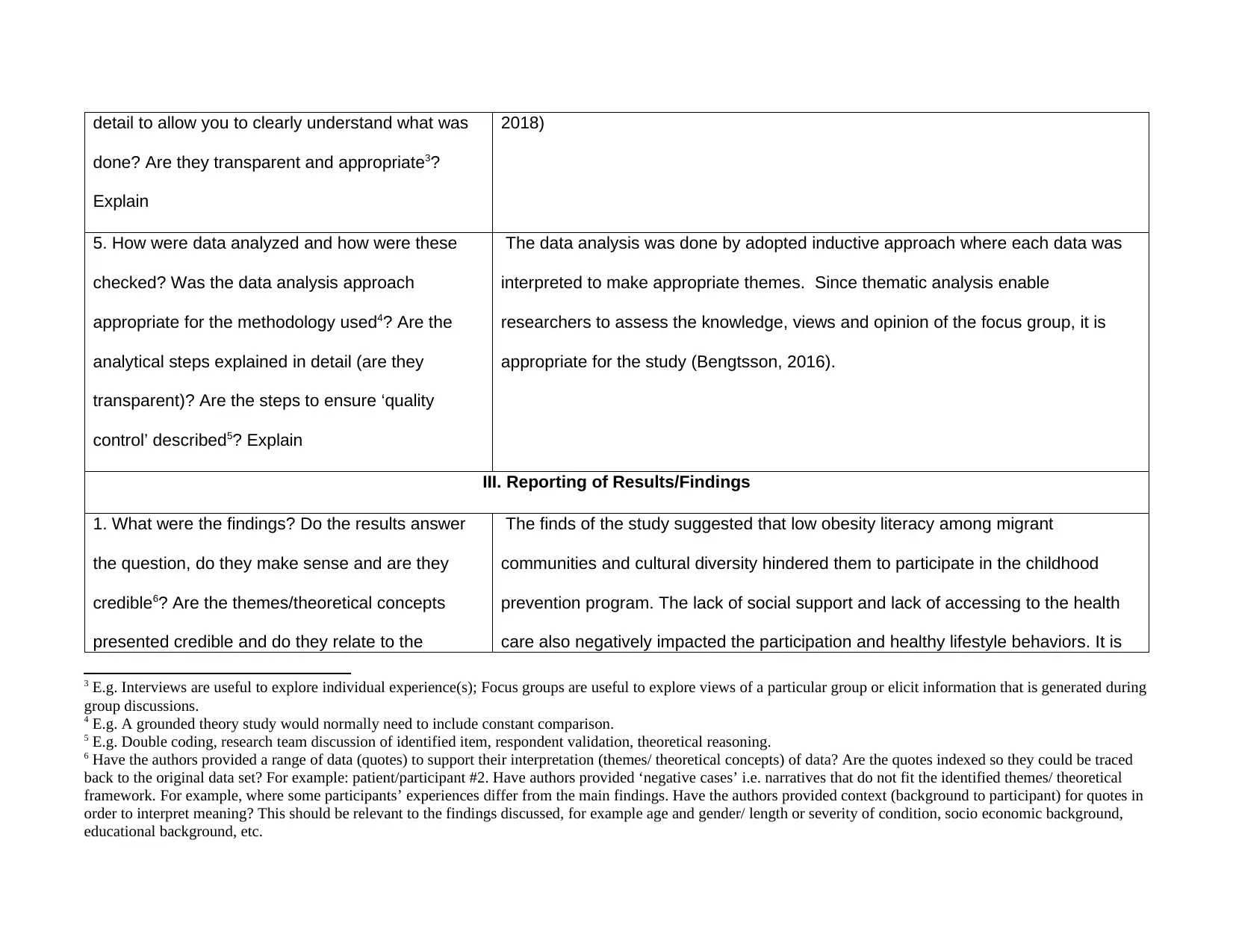
detail to allow you to clearly understand what was
done? Are they transparent and appropriate3?
Explain
2018)
5. How were data analyzed and how were these
checked? Was the data analysis approach
appropriate for the methodology used4? Are the
analytical steps explained in detail (are they
transparent)? Are the steps to ensure ‘quality
control’ described5? Explain
The data analysis was done by adopted inductive approach where each data was
interpreted to make appropriate themes. Since thematic analysis enable
researchers to assess the knowledge, views and opinion of the focus group, it is
appropriate for the study (Bengtsson, 2016).
III. Reporting of Results/Findings
1. What were the findings? Do the results answer
the question, do they make sense and are they
credible6? Are the themes/theoretical concepts
presented credible and do they relate to the
The finds of the study suggested that low obesity literacy among migrant
communities and cultural diversity hindered them to participate in the childhood
prevention program. The lack of social support and lack of accessing to the health
care also negatively impacted the participation and healthy lifestyle behaviors. It is
3 E.g. Interviews are useful to explore individual experience(s); Focus groups are useful to explore views of a particular group or elicit information that is generated during
group discussions.
4 E.g. A grounded theory study would normally need to include constant comparison.
5 E.g. Double coding, research team discussion of identified item, respondent validation, theoretical reasoning.
6 Have the authors provided a range of data (quotes) to support their interpretation (themes/ theoretical concepts) of data? Are the quotes indexed so they could be traced
back to the original data set? For example: patient/participant #2. Have authors provided ‘negative cases’ i.e. narratives that do not fit the identified themes/ theoretical
framework. For example, where some participants’ experiences differ from the main findings. Have the authors provided context (background to participant) for quotes in
order to interpret meaning? This should be relevant to the findings discussed, for example age and gender/ length or severity of condition, socio economic background,
educational background, etc.
done? Are they transparent and appropriate3?
Explain
2018)
5. How were data analyzed and how were these
checked? Was the data analysis approach
appropriate for the methodology used4? Are the
analytical steps explained in detail (are they
transparent)? Are the steps to ensure ‘quality
control’ described5? Explain
The data analysis was done by adopted inductive approach where each data was
interpreted to make appropriate themes. Since thematic analysis enable
researchers to assess the knowledge, views and opinion of the focus group, it is
appropriate for the study (Bengtsson, 2016).
III. Reporting of Results/Findings
1. What were the findings? Do the results answer
the question, do they make sense and are they
credible6? Are the themes/theoretical concepts
presented credible and do they relate to the
The finds of the study suggested that low obesity literacy among migrant
communities and cultural diversity hindered them to participate in the childhood
prevention program. The lack of social support and lack of accessing to the health
care also negatively impacted the participation and healthy lifestyle behaviors. It is
3 E.g. Interviews are useful to explore individual experience(s); Focus groups are useful to explore views of a particular group or elicit information that is generated during
group discussions.
4 E.g. A grounded theory study would normally need to include constant comparison.
5 E.g. Double coding, research team discussion of identified item, respondent validation, theoretical reasoning.
6 Have the authors provided a range of data (quotes) to support their interpretation (themes/ theoretical concepts) of data? Are the quotes indexed so they could be traced
back to the original data set? For example: patient/participant #2. Have authors provided ‘negative cases’ i.e. narratives that do not fit the identified themes/ theoretical
framework. For example, where some participants’ experiences differ from the main findings. Have the authors provided context (background to participant) for quotes in
order to interpret meaning? This should be relevant to the findings discussed, for example age and gender/ length or severity of condition, socio economic background,
educational background, etc.
Paraphrase This Document
Need a fresh take? Get an instant paraphrase of this document with our AI Paraphraser
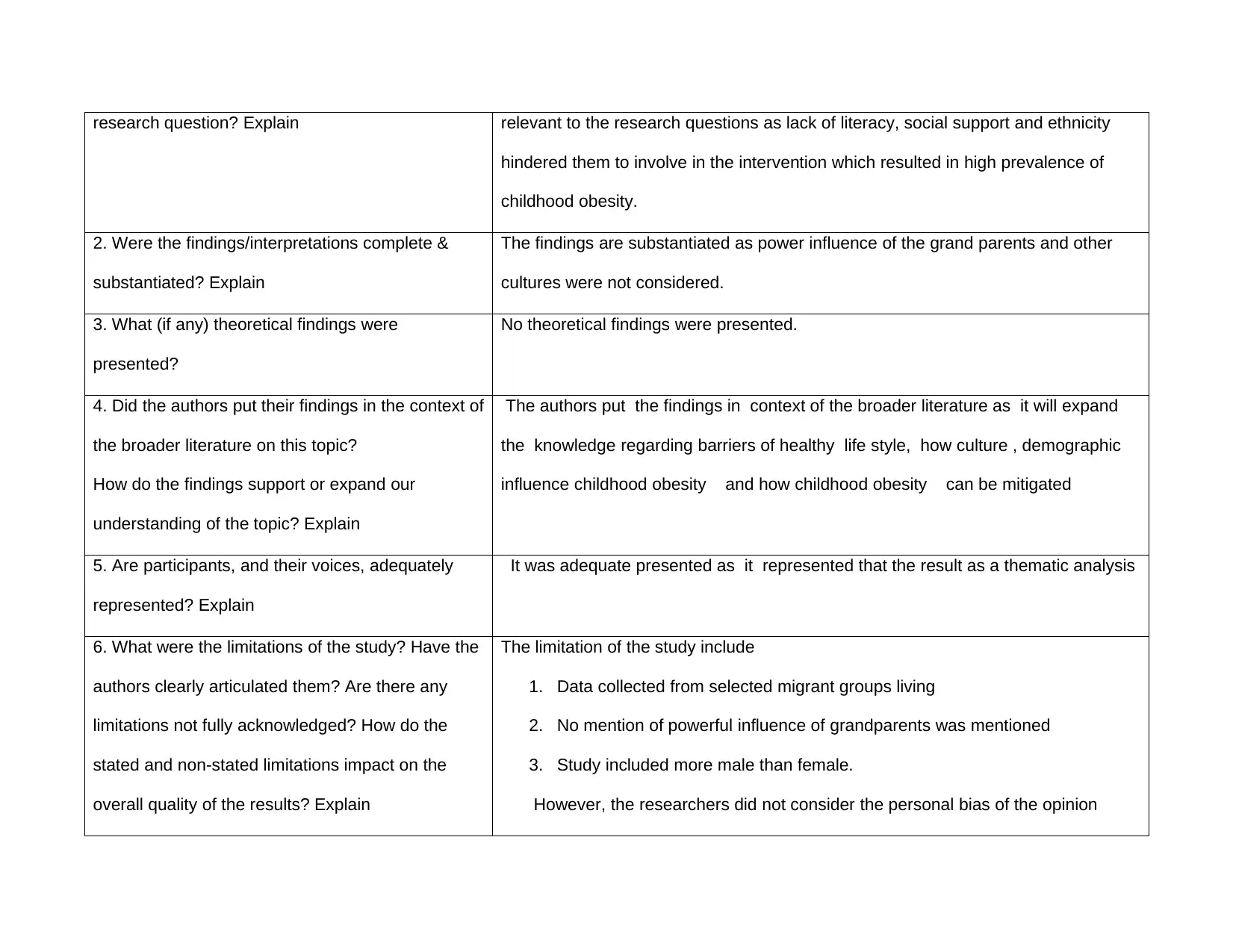
research question? Explain relevant to the research questions as lack of literacy, social support and ethnicity
hindered them to involve in the intervention which resulted in high prevalence of
childhood obesity.
2. Were the findings/interpretations complete &
substantiated? Explain
The findings are substantiated as power influence of the grand parents and other
cultures were not considered.
3. What (if any) theoretical findings were
presented?
No theoretical findings were presented.
4. Did the authors put their findings in the context of
the broader literature on this topic?
How do the findings support or expand our
understanding of the topic? Explain
The authors put the findings in context of the broader literature as it will expand
the knowledge regarding barriers of healthy life style, how culture , demographic
influence childhood obesity and how childhood obesity can be mitigated
5. Are participants, and their voices, adequately
represented? Explain
It was adequate presented as it represented that the result as a thematic analysis
6. What were the limitations of the study? Have the
authors clearly articulated them? Are there any
limitations not fully acknowledged? How do the
stated and non-stated limitations impact on the
overall quality of the results? Explain
The limitation of the study include
1. Data collected from selected migrant groups living
2. No mention of powerful influence of grandparents was mentioned
3. Study included more male than female.
However, the researchers did not consider the personal bias of the opinion
hindered them to involve in the intervention which resulted in high prevalence of
childhood obesity.
2. Were the findings/interpretations complete &
substantiated? Explain
The findings are substantiated as power influence of the grand parents and other
cultures were not considered.
3. What (if any) theoretical findings were
presented?
No theoretical findings were presented.
4. Did the authors put their findings in the context of
the broader literature on this topic?
How do the findings support or expand our
understanding of the topic? Explain
The authors put the findings in context of the broader literature as it will expand
the knowledge regarding barriers of healthy life style, how culture , demographic
influence childhood obesity and how childhood obesity can be mitigated
5. Are participants, and their voices, adequately
represented? Explain
It was adequate presented as it represented that the result as a thematic analysis
6. What were the limitations of the study? Have the
authors clearly articulated them? Are there any
limitations not fully acknowledged? How do the
stated and non-stated limitations impact on the
overall quality of the results? Explain
The limitation of the study include
1. Data collected from selected migrant groups living
2. No mention of powerful influence of grandparents was mentioned
3. Study included more male than female.
However, the researchers did not consider the personal bias of the opinion
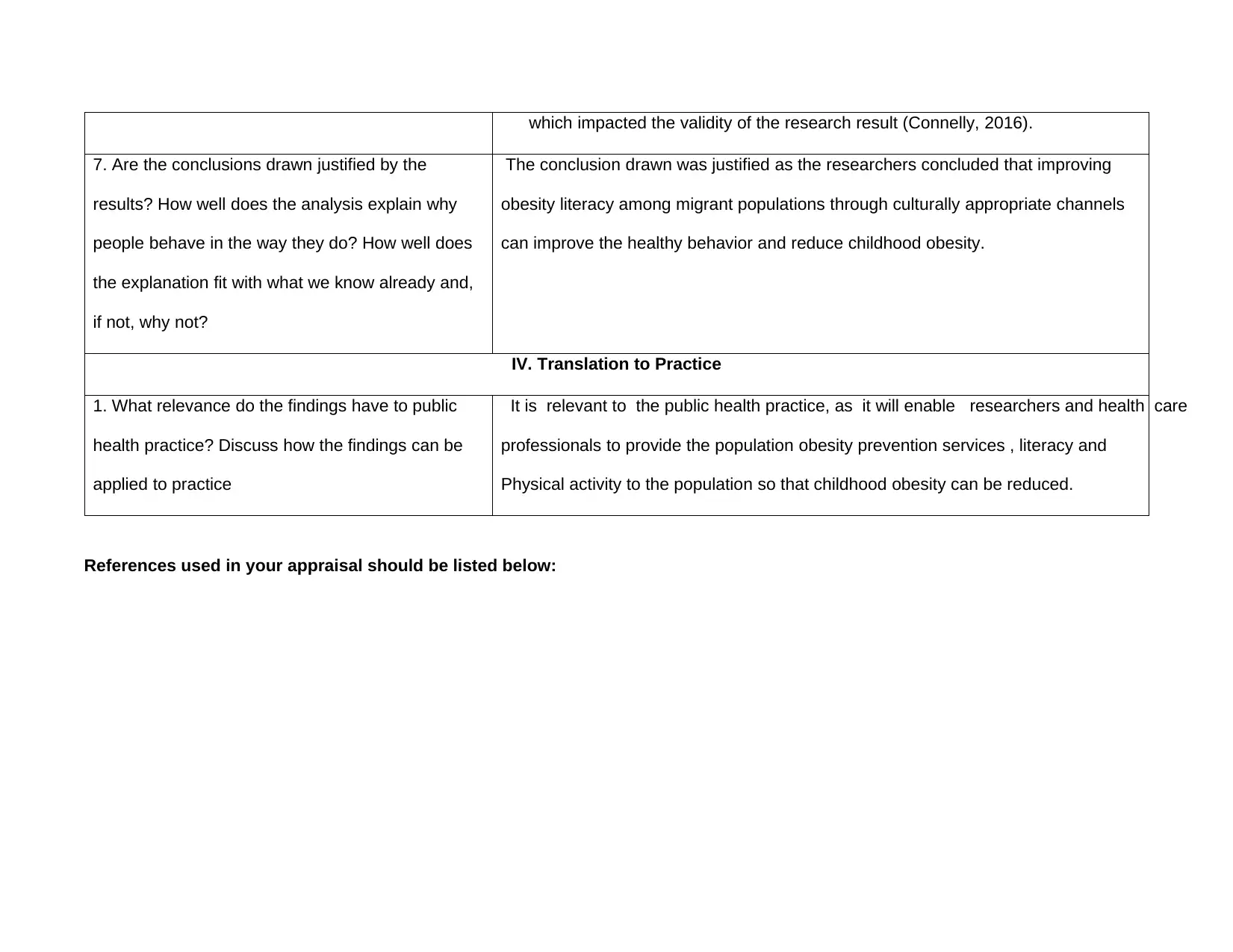
which impacted the validity of the research result (Connelly, 2016).
7. Are the conclusions drawn justified by the
results? How well does the analysis explain why
people behave in the way they do? How well does
the explanation fit with what we know already and,
if not, why not?
The conclusion drawn was justified as the researchers concluded that improving
obesity literacy among migrant populations through culturally appropriate channels
can improve the healthy behavior and reduce childhood obesity.
IV. Translation to Practice
1. What relevance do the findings have to public
health practice? Discuss how the findings can be
applied to practice
It is relevant to the public health practice, as it will enable researchers and health care
professionals to provide the population obesity prevention services , literacy and
Physical activity to the population so that childhood obesity can be reduced.
References used in your appraisal should be listed below:
7. Are the conclusions drawn justified by the
results? How well does the analysis explain why
people behave in the way they do? How well does
the explanation fit with what we know already and,
if not, why not?
The conclusion drawn was justified as the researchers concluded that improving
obesity literacy among migrant populations through culturally appropriate channels
can improve the healthy behavior and reduce childhood obesity.
IV. Translation to Practice
1. What relevance do the findings have to public
health practice? Discuss how the findings can be
applied to practice
It is relevant to the public health practice, as it will enable researchers and health care
professionals to provide the population obesity prevention services , literacy and
Physical activity to the population so that childhood obesity can be reduced.
References used in your appraisal should be listed below:
⊘ This is a preview!⊘
Do you want full access?
Subscribe today to unlock all pages.

Trusted by 1+ million students worldwide
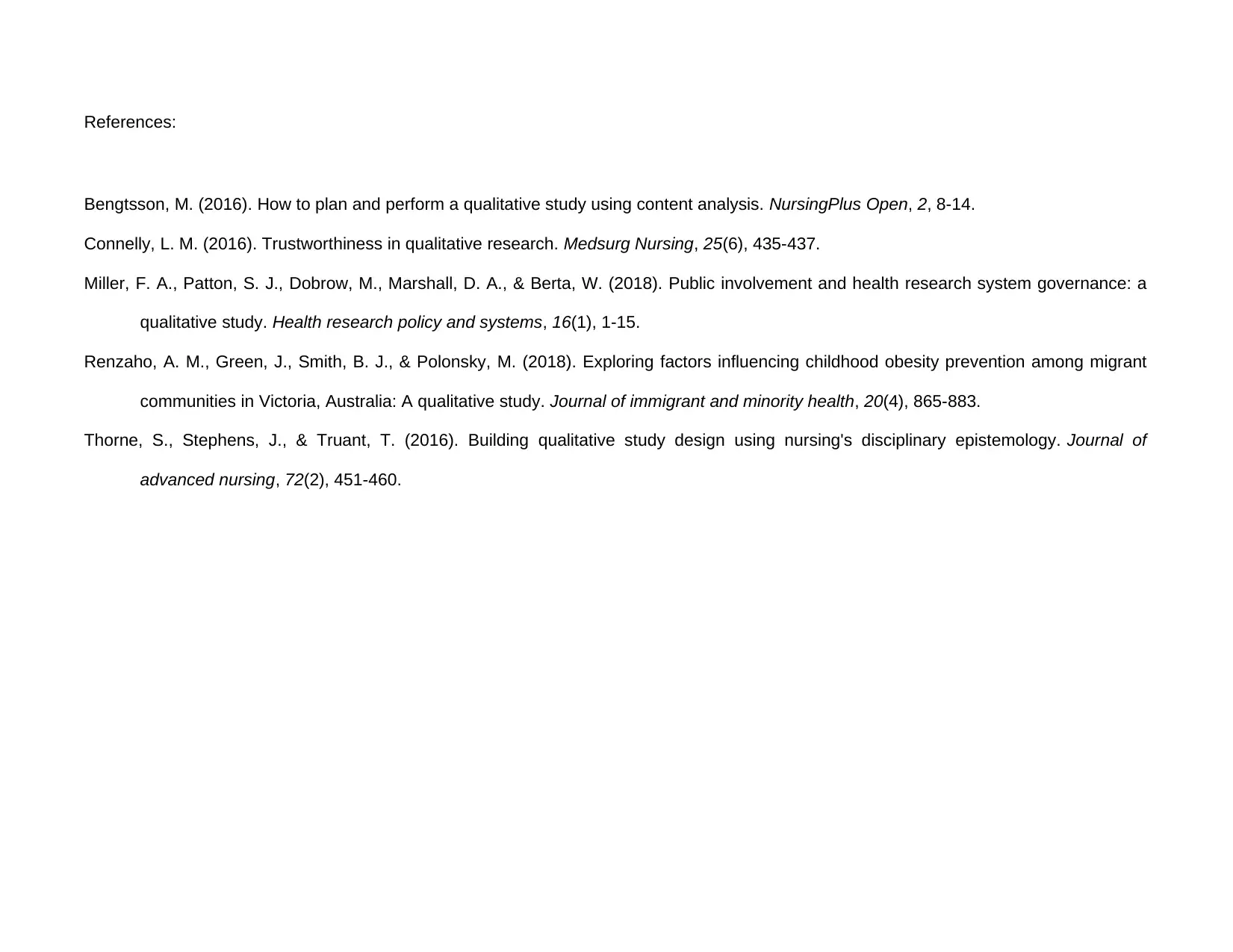
References:
Bengtsson, M. (2016). How to plan and perform a qualitative study using content analysis. NursingPlus Open, 2, 8-14.
Connelly, L. M. (2016). Trustworthiness in qualitative research. Medsurg Nursing, 25(6), 435-437.
Miller, F. A., Patton, S. J., Dobrow, M., Marshall, D. A., & Berta, W. (2018). Public involvement and health research system governance: a
qualitative study. Health research policy and systems, 16(1), 1-15.
Renzaho, A. M., Green, J., Smith, B. J., & Polonsky, M. (2018). Exploring factors influencing childhood obesity prevention among migrant
communities in Victoria, Australia: A qualitative study. Journal of immigrant and minority health, 20(4), 865-883.
Thorne, S., Stephens, J., & Truant, T. (2016). Building qualitative study design using nursing's disciplinary epistemology. Journal of
advanced nursing, 72(2), 451-460.
Bengtsson, M. (2016). How to plan and perform a qualitative study using content analysis. NursingPlus Open, 2, 8-14.
Connelly, L. M. (2016). Trustworthiness in qualitative research. Medsurg Nursing, 25(6), 435-437.
Miller, F. A., Patton, S. J., Dobrow, M., Marshall, D. A., & Berta, W. (2018). Public involvement and health research system governance: a
qualitative study. Health research policy and systems, 16(1), 1-15.
Renzaho, A. M., Green, J., Smith, B. J., & Polonsky, M. (2018). Exploring factors influencing childhood obesity prevention among migrant
communities in Victoria, Australia: A qualitative study. Journal of immigrant and minority health, 20(4), 865-883.
Thorne, S., Stephens, J., & Truant, T. (2016). Building qualitative study design using nursing's disciplinary epistemology. Journal of
advanced nursing, 72(2), 451-460.
1 out of 10
Related Documents
Your All-in-One AI-Powered Toolkit for Academic Success.
+13062052269
info@desklib.com
Available 24*7 on WhatsApp / Email
![[object Object]](/_next/static/media/star-bottom.7253800d.svg)
Unlock your academic potential
Copyright © 2020–2025 A2Z Services. All Rights Reserved. Developed and managed by ZUCOL.





